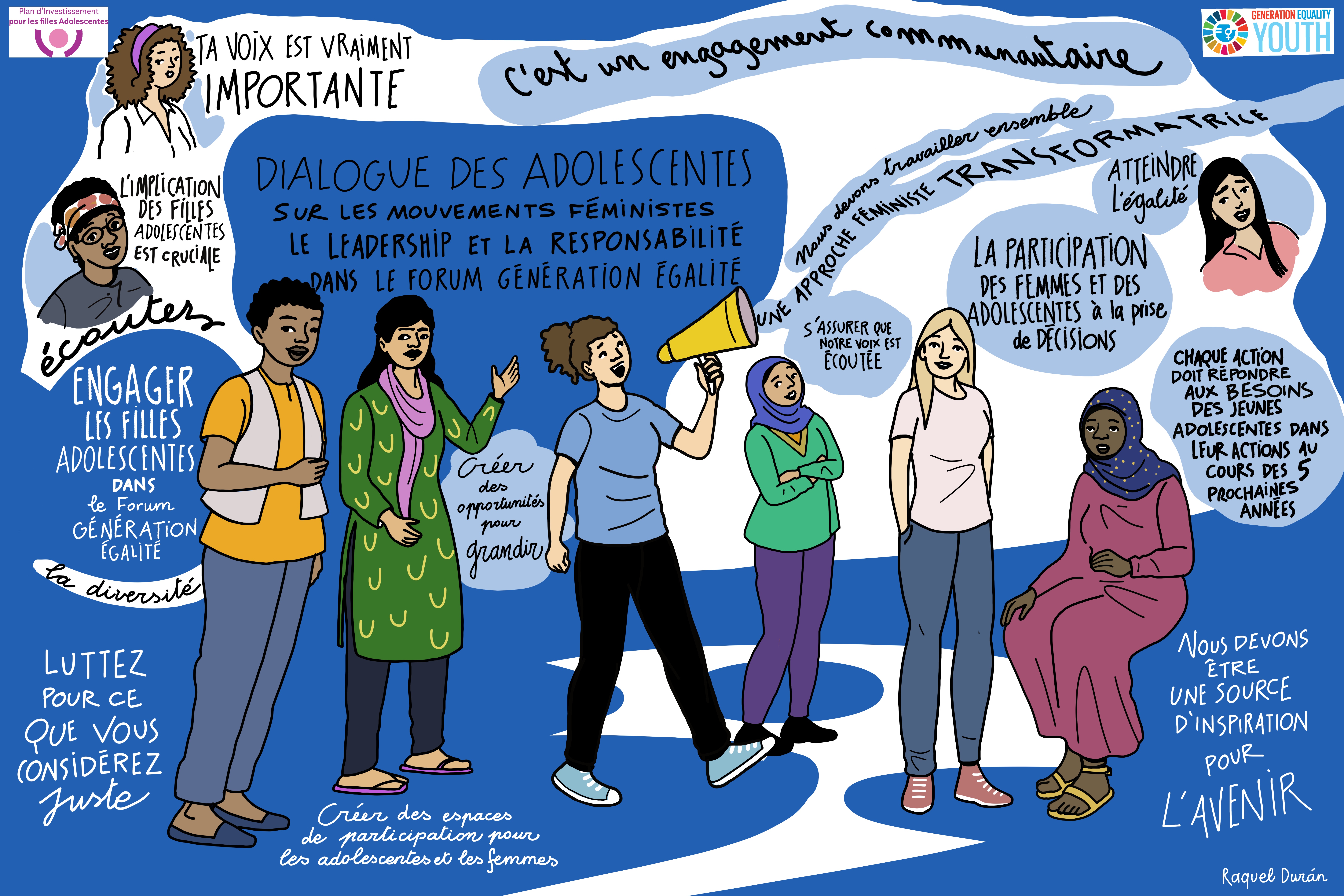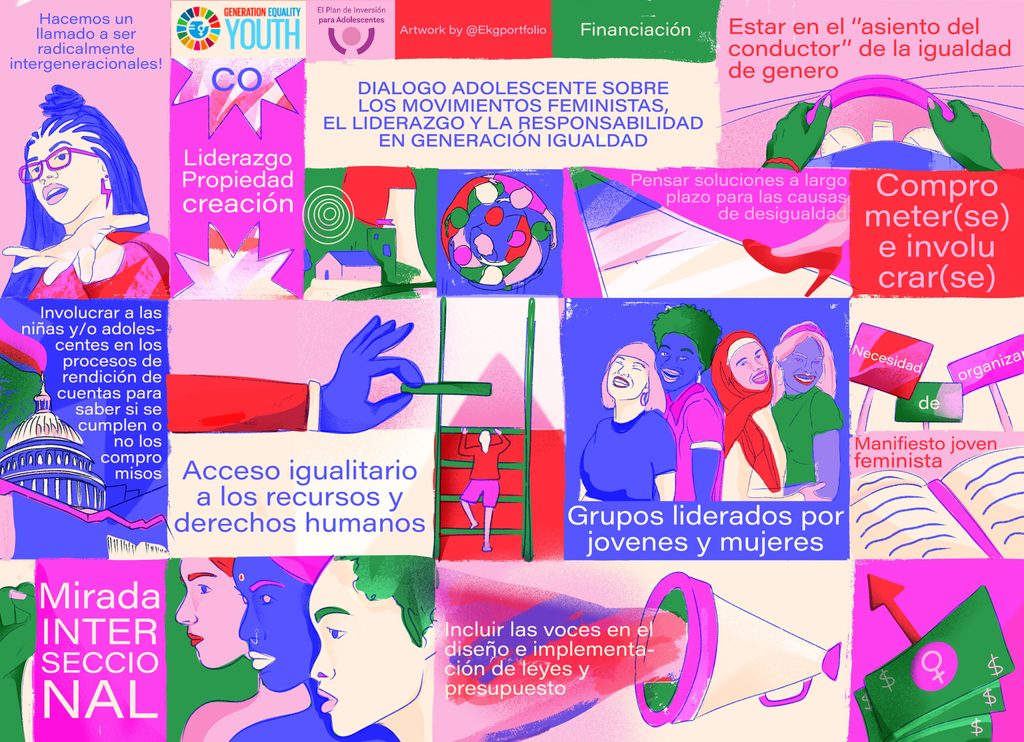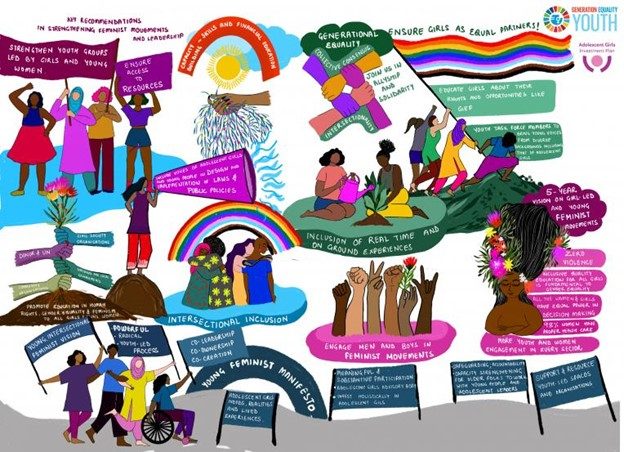Will It Be Youth Participation or Co-Creation in Generation Equality?
1 April 2021What does participation look like as we continue to engage in the Generation Equality process?

Three illustrators listened in to the event and captured the conversation. French Artwork by Raquel Durán.
As civil society continues to work in allyship to adolescents and young people, we have been both challenged and inspired by the young feminist organising that has worked to carve out space in the multi-stakeholder process of Generation Equality. Recently with the launch of the GEF Young Feminist Manifesto a fundamental question arises: what does participation look like as we continue to engage in these processes?
On the margins of the 65th Commission on the Status of Women (CSW65, 15 to 26 March 2021), the Adolescent Girls Investment Plan (AGIP), a coalition of global, intergenerational partners working to affect change for adolescent girls, co-hosted a multi-generational dialogue on adolescent feminist leadership and accountability in Generation Equality. Together with the Youth Taskforce, we drafted a program that would demonstrate how girl leadership can help enrich the Generation Equality process and ensure that the priorities of young women and girls crucially shape its outcome.
We invited our co-sponsors from AC leadership, Malawi, Canada, Sweden and Mexico, to share their Generation Equality plans with selected youth activists, who in turn had the space to review and critique the plans’ actions and commitments. Katherine Dibbon, a Youth Taskforce member participating in the dialogue, urged all GE leaders first to make change: “Our movement must change, we need to be radically intergenerational, actively engaging with girls and young people of all identities.”

Adolescent leaders Yulianis, Thuba, and Mushfiqa also spoke at the dialogue, and their comments went far beyond critiquing the substance of the actions defined for Generation Equality. They defended their own rights within the feminist movement and demanded an intersectional viewpoint that prevents all forms of discrimination by age, race, sexual orientation, or gender identity. “We don’t want to be invited to speak, we want to be invited to CO-CREATE with everyone else,” Yulianis, a youth advocate from Colombia, laid out. Without concrete steps to incorporate their leadership, youth leaders fear that Generation Equality will simply be a missed opportunity.
We are experts, the Young Feminist Manifesto declares. This manifesto, created as a result of a powerful, co-creative process led by young feminists, is a call to action and a reckoning for all actors engaged in Generation Equality and other relevant international processes. It is no longer acceptable to only invite youth and adolescents to join when adults decide when and how they would be consulted. If the issue, policy, or commitment touches on their lives and dreams, young people must be invited as decision makers. “Participation cannot be equated with ‘leaderships” said Chandreyi Guharay of Young Feminist Europe (Youth AC leader). We need to move beyond the narrative of consultation and participation to one of leadership, co-creation, and co-ownership. Other adjustments must also be addressed, such as adequate compensation to youth time, expertise and emotional labour, as they bring their issues to the agenda while also educating the adults in these spaces on what they need and want. “We came to Generation Equality with hope that youth tokenism would come to an end and youth leadership would become reality… It’s not enough to just give youth a seat at the table without recognising the challenges we are faced with,” Racha Haffar, GE Youth Taskforce Member, said.

In response to these calls for radical, intersectional, and accountable change, the Honorable Karina Gould, Minister of International Development for Canada, commented with specific tactics that Canada will promote as a co-leader of the Feminist Movement and Leadership Action Coalition around ‘Building opportunities for continued participation, continued growth and continued leadership,’ emphasising the need to accomplish this through consistent and dynamic engagement with youth leaders, and not as a one-time activity.
At the dialogue’s close, Youth Taskforce member and event moderator Pip Gardner reminded all attendees of the seven key principles in the manifesto: leadership, accountability, co-ownership, substantive and funded participation, transformative design, co-creation and intersectionality. At the heart of this effort is the appreciation of the connections between language, semantics and power. Our use of language around youth and adolescents in the process needs to proactively shift the power from engagement to leadership and co-creation and embrace the global movement around ‘Nothing about us without us’.
Let’s commit to working together to achieve a more inclusive, intersectional and power-balanced feminist movement where young feminists’ leadership is at the centre, and let’s help Mushfiqa, a youth advocate from Bangladesh, realise her dream for women and girls: ‘I want this movement to end within the next five years…. I believe women mean power, women mean freedom, and everything is possible for women and girls.”
For more information or to watch a recording of the event, please visit the AGIP site.
[Blog by Nihal Said, Pip Gardner, Katherine Dibbon, Racha Haffar, Eunice Garcia, Chandreyi Ghuharay, Yulianis, Mushfiqa and Thuba]
Categories: Education, Youth empowerment


